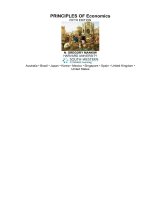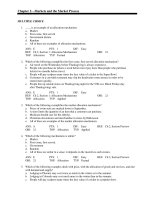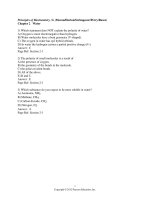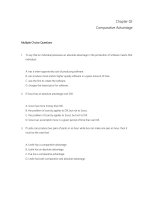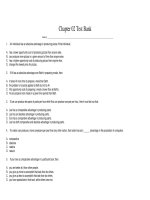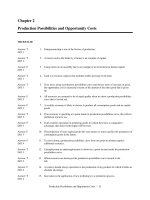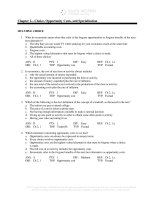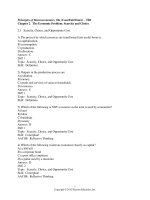Principles of economics 5th edition
Bạn đang xem bản rút gọn của tài liệu. Xem và tải ngay bản đầy đủ của tài liệu tại đây (28.92 MB, 922 trang )
PRINCIPLES OF Economics
FIFTH EDITION
N. GREGORY MANKIW
HARVARD UNIVERSITY
Australia • Brazil • Japan • Korea • Mexico • Singapore • Spain • United Kingdom •
United States
Principles of Economics, 5e
N. Gregory Mankiw
Vice President of Editorial, Business: Jack W. Calhoun
Vice President/Editor-in-Chief: Alex von Rosenberg
Executive Editor: Mike Worls
Developmental Editor: Jane Tufts
Contributing Editors: Jennifer E. Thomas and Katie Yanos
Executive Marketing Manager: Brian Joyner
Marketing Coordinator: Suellen Ruttkay
Senior Content Project Manager: Colleen A. Farmer
Marketing Communications Manager: Sarah Greber
Manager of Technology, Editorial: Pam Wallace
Media Editor: Deepak Kumar
Senior Frontlist Buyer, Manufacturing: Sandee Milewski
Production Service: Lachina Publishing Services
Senior Art Director: Michelle Kunkler
Internal and Cover Designer: Red Hangar Design, LLC
Internal Paintings: © Michael Steirnagle/Munro Campagna Artistic Representatives
Cover Painting: © Fine Art Photographic Library/CORBIS
Photography Manager: Deanna Ettinger
Photo Researcher: Charlotte Goldman
© 2009, 2007 South-Western, a part of Cengage Learning
ALL RIGHTS RESERVED. No part of this work covered by the copyright hereon may be
reproduced or used in any form or by any means—graphic, electronic, or mechanical,
including photocopying, recording, taping, Web distribution, information storage and
retrieval systems, or in any other manner—except as may be permitted by the license
terms herein.
For product information and technology assistance, contact us at
Cengage Learning Customer & Sales Support, 1-800-354-9706
For permission to use material from this text or product,
submit all requests online at
www.cengage.com/permissions
Further permissions questions can be emailed to
Exam View
®
is a registered trademark of eInstruction Corp. Windows is a registered
trademark of the Microsoft Corporation used herein under license. Macintosh and
Power Macintosh are registered trademarks of Apple Computer, Inc. used herein under
license.
© 2008 Cengage Learning. All Rights Reserved.
Cengage Learning WebTutor
TM
is a trademark of Cengage Learning.
Library of Congress Control Number: 2008934555
ISBN-13: 978-0-324-58997-9
ISBN-10: 0-324-58997-2
Instructor’s Edition ISBN 13: 978-0-324-59133-0
Instructor’s Edition ISBN 10: 0-324-59133-0
South-Western Cengage Learning
5191 Natorp Boulevard
Mason, OH 45040
USA
Cengage Learning products are represented in Canada by Nelson Education, Ltd.
For your course and learning solutions, visit
academic.cengage.com
Purchase any of our products at your local college store or at our preferred online store
www.ichapters.com
Printed in the United States of America
1 2 3 4 5 6 7 12 11 10 09 08
To Catherine, Nicholas, and Peter, my other contributions to the next generation
About the Author
N. Gregory Mankiw is professor of economics at Harvard University. As a student, he
studied economics at Princeton University and MIT. As a teacher, he has taught
macroeconomics, microeconomics, statistics, and principles of economics. He even
spent one summer long ago as a sailing instructor on Long Beach Island.
Professor Mankiw is a prolific writer and a regular participant in academic and policy
debates. His work has been published in scholarly journals, such as the American
Economic Review, Journal of Political Economy, and Quarterly Journal of Economics,
and in more popular forums, such as The New York Times and The Wall Street
Journal. He is also author of the best-selling intermediate-level textbook
Macroeconomics(Worth Publishers). In addition to his teaching, research, and writing,
Professor Mankiw has been a research associate of the National Bureau of Economic
Research, an adviser to the Federal Reserve Bank of Boston and the Congressional
Budget Office, and a member of the ETS test development committee for the Advanced
Placement exam in economics. From 2003 to 2005, he served as chairman of the
President’s Council of Economic Advisers.
Professor Mankiw lives in Wellesley, Massachusetts, with his wife, Deborah, three
children, Catherine, Nicholas, and Peter, and their border terrier, Tobin.
Brief Contents
PART I INTRODUCTION
CHAPTER1Ten Principles of Economics
CHAPTER2Thinking Like an Economist
CHAPTER3Interdependence and the Gains from Trade
PART II HOW MARKETS WORK
CHAPTER4The Market Forces of Supply and Demand
CHAPTER5Elasticity and Its Application
CHAPTER6Supply, Demand, and Government Policies
PART III MARKETS AND WELFARE
CHAPTER7Consumers, Producers, and the Efficiency of Markets
CHAPTER8Application: The Costs of Taxation
CHAPTER9Application: International Trade
PART IV THE ECONOMICS OF THE PUBLIC SECTOR
CHAPTER10Externalities
CHAPTER11Public Goods and Common Resources
CHAPTER12The Design of the Tax System
PART V FIRM BEHAVIOR AND THE ORGANIZATION OF INDUSTRY
CHAPTER13The Costs of Production
CHAPTER14Firms in Competitive Markets
CHAPTER15Monopoly
CHAPTER16Monopolistic Competition
CHAPTER17Oligopoly
PART VI THE ECONOMICS OF LABOR MARKETS
CHAPTER18The Markets for the Factors of Production
CHAPTER19Earnings and Discrimination
CHAPTER20Income Inequality and Poverty
PART VII TOPICS FOR FURTHER STUDY
CHAPTER21The Theory of Consumer Choice
CHAPTER22Frontiers of Microeconomics
PART VIII THE DATA OF MACROECONOMICS
CHAPTER23Measuring a Nation’s Income
CHAPTER24Measuring the Cost of Living
PART IX THE REAL ECONOMY IN THE LONG RUN
CHAPTER25Production and Growth
CHAPTER26Saving, Investment, and the Financial System
CHAPTER27The Basic Tools of Finance
CHAPTER28Unemployment
PART X MONEY AND PRICES IN THE LONG RUN
CHAPTER29The Monetary System
CHAPTER30Money Growth and Inflation
PART XI THE MACROECONOMICS OF OPEN ECONOMIES
CHAPTER31Open-Economy Macroeconomics: Basic Concepts
CHAPTER32A Macroeconomic Theory of the Open Economy
PART XII SHORT-RUN ECONOMIC FLUCTUATIONS
CHAPTER33Aggregate Demand and Aggregate Supply
CHAPTER34The Influence of Monetary and Fiscal Policy on Aggregate Demand
CHAPTER35The Short-Run Trade-off between Inflation and Unemployment
PART XIII FINAL THOUGHTS
CHAPTER36Five Debates over Macroeconomic Policy
“Economics is a study of mankind in the ordinary business of life.” So wrote Alfred
Marshall, the great 19th-century economist, in his textbook, Principles of Economics.
Although we have learned much about the economy since Marshall’s time, this
definition of economics is as true today as it was in 1890, when the first edition of his
text was published.
Why should you, as a student at the beginning of the 21st century, embark on the study
of economics? There are three reasons.
The first reason to study economics is that it will help you understand the world in which
you live. There are many questions about the economy that might spark your curiosity.
Why are apartments so hard to find in New York City? Why do airlines charge less for a
round-trip ticket if the traveler stays over a Saturday night? Why is Johnny Depp paid so
much to star in movies? Why are living standards so meager in many African countries?
Why do some countries have high rates of inflation while others have stable prices?
Why are jobs easy to find in some years and hard to find in others? These are just a few
of the questions that a course in economics will help you answer.
The second reason to study economics is that it will make you a more astute participant
in the economy. As you go about your life, you make many economic decisions. While
you are a student, you decide how many years to stay in school. Once you take a job,
you decide how much of your income to spend, how much to save, and how to invest
your savings. Someday you may find yourself running a small business or a large
corporation, and you will decide what prices to charge for your products. The insights
developed in the coming chapters will give you a new perspective on how best to make
these decisions. Studying economics will not by itself make you rich, but it will give you
some tools that may help in that endeavor.
The third reason to study economics is that it will give you a better understanding of
both the potential and the limits of economic policy. Economic questions are always on
the minds of policymakers in mayors’ offices, governors’ mansions, and the White
House. What are the burdens associated with alternative forms of taxation? What are
the effects of free trade with other countries? What is the best way to protect the
environment? How does a government budget deficit affect the economy? As a voter,
you help choose the policies that guide the allocation of society’s resources. An
understanding of economics will help you carry out that responsibility. And who knows:
Perhaps someday you will end up as one of those policymakers yourself.
Thus, the principles of economics can be applied in many of life’s situations. Whether
the future finds you reading the newspaper, running a business, or sitting in the Oval
Office, you will be glad that you studied economics.
N. Gregory Mankiw September 2008
Mankiw 5e. Experience It.
We know you are often short on time. But you can maximize your efforts — and results
— when you Experience Mankiw Fifth Edition’s engaging learning tools. With the
product support website and EconCentral, you’ll quickly reinforce chapter concepts and
sharpen your skills with interactive, hands-on applications online.
If a printed Study Guide better suits your needs and study habits, the Mankiw 5e Study
Guide is unsurpassed in its careful attention to accuracy, concise language, and
practice that enhances your study time.
Product Support Website
www.cengage.com/economics/mankiw
The Mankiw product support website is an easy online stop. Here, you’ll fi nd access to
free quizzing, Student Note Prompt handouts for the Premium PowerPoint
®
your
instructor may use, and other resources.
Study Guide
Helping you achieve your personal best, the Mankiw Study Guide is based completely
on the Fifth Edition, covering chapter material comprehensively — and accurately. Very
hands-on, each chapter thoroughly covers the material in the corresponding chapter of
Mankiw. Every key word and concept is addressed within the Study Guide chapter —
meaning you’ll feel confi dent that if you can do the study guide, you will understand all
of the material in that chapter of Mankiw.
The “types” of questions used in the Study Guide reflect what you fi nd most useful
when studying. Our student surveys show that students like you felt that fill-in-the-blank
questions, matching questions, and questions without specific single answers were an
inefficient use of their time — and the Mankiw Study Guide avoids these kinds of
questions.
To order the study guide, visit
www.ichapters.com
.
Self-Study Solutions
EconCentral
Multiple resources for learning and reinforcing principles concepts are now available in
one place! EconCentral is your one-stop shop for the learning tools and activities to help
you succeed.
At a minimal extra cost, EconCentral equips you with a portal to a wealth of resources
that help you both study and apply economic concepts. As you read and study the
chapters, you can access video tutorials with Greg Mankiw Answers Key Questions, 10
Principles Videos, and Ask the Instructor Videos. You can review with Flash Cards and
the Graphing Workshop, check your understanding of the chapter with interactive
quizzing, and print Student Note Prompt handouts for the Premium PowerPoint
®
to
make note-taking in class much more efficient.
Ready to apply chapter concepts to the real world? EconCentral gives you ABC News
videos, EconNews articles, Economic debates, Links to Economic Data, and more. All
the study and application resources in EconCentral are organized by chapter to help
you get the most from the Mankiw text and from your classes.
Visit
www.cengage.com/economics/mankiw/5e/econcentral
to see the study options available!
Acknowledgments
In writing this book, I benefited from the input of many talented people. Indeed, the list
of people who have contributed to this project is so long, and their contributions so
valuable, that it seems an injustice that only a single name appears on the cover.
Let me begin with my colleagues in the economics profession. The four editions of this
text and its supplemental materials have benefited enormously from their input. In
reviews and surveys, they have offered suggestions, identified challenges, and shared
ideas from their own classroom experience. I am indebted to them for the perspectives
they have brought to the text. Unfortunately, the list has become too long to thank those
who contributed to previous editions, even though students reading the current edition
are still benefiting from their insights.
Most important in this process have been Ron Cronovich (Carthage College) and David
Hakes (University of Northern Iowa). Ron and David, both dedicated teachers, have
served as reliable sounding boards for ideas and hardworking partners with me in
putting together the superb package of supplements.
For this new edition, the following diary reviewers recorded their day-to-day experience
over the course of a semester, offering detailed suggestions about how to improve the
text.
John Crooker, University of Central Missouri
Rachel Friedberg, Brown University
Greg Hunter, California State University, Polytechnic, Pomona
Lillian Kamal, Northwestern University
Francis Kemegue, Bryant University
Douglas Miller, University of Missouri
Babu Nahata, University of Louisville
Edward Skelton, Southern Methodist University
The following reviewers of the fourth edition provided suggestions for refining the
content, organization, and approach in the fifth.
Syed Ahmed, Cameron University
Farhad Ameen, State University of New York, Westchester Community College
Mohammad Bajwa, Northampton Community College
Carl Bauer, Oakton Community College
Roberta Biby, Grand Valley State University
Stephen Billings, University of Colorado at Boulder
Bruce Brown, California State University, Polytechnic, Pomona
Lynn Burbridge, Northern Kentucky University
Mark Chester, Reading Area Community College
David Ching, University of Hawaii, Manoa
Sarah Cosgrove, University of Massachusetts, Dartmouth
Craig Depken, University of North Carolina, Charlotte
Angela Dzata, Alabama State University
Jose Esteban, Palomar College
Mark Frascatore, Clarkson University
Satyajit Ghosh, University of Scranton
Soma Ghosh, Bridgewater State College
Daniel Giedeman, Grand Valley State University
Robert L. Holland, Purdue University
Anisul Islam, University of Houston, Downtown
Nancy Jianakoplos, Colorado State University
Paul Johnson, University of Alaska, Anchorage
Robert Jones, University of Massachusetts, Dartmouth
Lillian Kamal, Northwestern University
Jongsung Kim, Bryant University
Marek Kolar, Delta College
Leonard Lardaro, University of Rhode Island
Nazma Latif-Zaman, Providence College
William Mertens, University of Colorado
Francis Mummery, Fullerton College
David Mushinski, Colorado State University
Christopher Mushrush, Illinois State University
Babu Nahata, University of Louisville
Laudo Ogura, Grand Valley State University
Michael Patrono, Okaloosa-Walton College
Jeff Rubin, Rutgers University, New Brunswick
Samuel Sarri, College of Southern Nevada
Harinder Singh, Grand Valley State University
David Spencer, University of Michigan
David Switzer, Saint Cloud State University
Henry Terrell, University of Maryland
Ngocbich Tran, San Jacinto College
Miao Wang, Marquette University
Elizabeth Wheaton, Southern Methodist University
Martin Zelder, Northwestern University
I received detailed feedback on specific elements in the text, including all end-of-chapter
problems and applications, from the following instructors.
Casey R. Abington, Kansas State University
Seemi Ahmad, Dutchess Community College
Farhad Ameen, State University of New York, Westchester Community College
J. J. Arias, Georgia College & State University
James Bathgate, Willamette University
Scott Beaulier, Mercer University
Clive Belfield, Queens College
Calvin Blackwell, College of Charleston
Cecil E. Bohanon, Ball State University
Douglas Campbell, University of Memphis
Michael G. Carew, Baruch College
Sewin Chan, New York University
Joyce J. Chen, The Ohio State University
Edward A. Cohn, Del Mar College
Chad D. Cotti, University of South Carolina
Erik D. Craft, University of Richmond
Eleanor D. Craig, University of Delaware
Abdelmagead Elbiali, Rio Hondo College
Harold W. Elder, University of Alabama
Hadi Salehi Esfahani, University of Illinois, Urbana-Champaign
David Franck, Francis Marion University
Amanda S. Freeman, Kansas State University
J.P. Gilbert, MiraCosta College
Joanne Guo, Dyson College of Pace University
Charles E. Hegji, Auburn University at Montgomery
Andrew J. Hussey, University of Memphis
Hans R. Isakson, University of Northern Iowa
Simran Kahai, John Carroll University
David E. Kalist, Shippensburg University
Mark P. Karscig, University of Central Missouri
Theodore Kuhn, Butler University
Dong Li, Kansas State University
Daniel Lin, George Mason University
Nathaniel Manning, Southern University
Vince Marra, University of Delaware
Akbar Marvasti, University of Southern Mississippi
Heather Mattson, University of Saint Thomas
Charles C. Moul, Washington University in St. Louis
Albert A. Okunade, University of Memphis
J. Brian O’Roark, Robert Morris University
Anthony L. Ostrosky, Illinois State University
Nitin V. Paranjpe, Wayne State University & Oakland University
Sanela Por a, University of South Carolina, Aiken
Walter G. Park, American University
Reza M. Ramazani, Saint Michael’s College
Rhonda Vonshay Sharpe, University of Vermont
Carolyn Fabian Stumph, Indiana University–Purdue University Fort Wayne
Rick Tannery, Slippery Rock University
Aditi Thapar, New York University
Michael H. Tew, Troy University
Jennifer A. Vincent, Champlain College
Milos Vulanovic, Lehman College
Bhavneet Walia, Kansas State University
Douglas M. Walker, College of Charleston
Patrick Walsh, Saint Michael’s College
Larry Wolfenbarger, Macon State College
William C. Wood, James Madison University
Chiou-nan Yeh, Alabama State University
The accuracy of a textbook is critically important. I am responsible for any remaining
errors, but I am grateful to the following professors for reading through the final
manuscript and page proofs with me:
Joel Dalafave, Bucks County Community College
Greg Hunter, California State University –Pomona
Lillian Kamal, Northwestern University
Francis Kemegue, Bryant University
Douglas Miller, University of Missouri
Ed Skelton, Southern Methodist University
The team of editors who worked on this book improved it tremendously. Jane Tufts,
developmental editor, provided truly spectacular editing—as she always does. Mike
Worls, economics executive editor, did a splendid job of overseeing the many people
involved in such a large project. Jennifer Thomas (senior developmental editor) and
Katie Yanos (developmental editor) were crucial in assembling an extensive and
thoughtful group of reviewers to give me feedback on the previous edition, while putting
together an excellent team to revise the supplements. Colleen Farmer, senior content
project manager, and Katherine Wilson, senior project manager, had the patience and
dedication necessary to turn my manuscript into this book. Michelle Kunkler, senior art
director, gave this book its clean, friendly look. Michael Steirnagle, the illustrator, helped
make the book more visually appealing and the economics in it less abstract. Carolyn
Crabtree, copyeditor, refined my prose, and Terry Casey, indexer, prepared a careful
and thorough index. Brian Joyner, executive marketing manager, worked long hours
getting the word out to potential users of this book. The rest of the Cengage team,
including Jean Buttrom, Sandra Milewski and Deepak Kumar, was also consistently
professional, enthusiastic, and dedicated.
I am grateful also to Josh Bookin, a former Advanced Placement economics teacher
and recently an extraordinary section leader for Ec 10, the introductory course at
Harvard. Josh helped me refine the manuscript and check the page proofs for this
edition.
As always, I must thank my “in-house” editor Deborah Mankiw. As the first reader of
almost everything I write, she continued to offer just the right mix of criticism and
encouragement.
Finally, I would like to mention my three children Catherine, Nicholas, and Peter. Their
contribution to this book was putting up with a father spending too many hours in his
study. The four of us have much in common—not least of which is our love of ice cream
(which becomes apparent in
Chapter 4
). Maybe sometime soon one of them will pick up my passion for economics as well.
N. Gregory Mankiw September 2008
Table of Contents
Preface: To the Student
PART I
INTRODUCTION
CHAPTER 1
TEN PRINCIPLES OF ECONOMICS
How People Make Decisions
Principle 1: People Face Trade-offs
Principle 2: The Cost of Something Is What You Give Up to Get It
Principle 3: Rational People Think at the Margin
Principle 4: People Respond to Incentives
How People Interact
Principle 5: Trade Can Make Everyone Better Off
Principle 6: Markets Are Usually a Good Way to Organize Economic Activity
IN THE NEWSIncentive Pay
Principle 7: Governments Can Sometimes Improve Market Outcomes
FYIAdam Smith and the Invisible Hand
How the Economy as a Whole Works
Principle 8: A Country’s Standard of Living Depends on Its Ability to Produce Goods and
Services
Principle 9: Prices Rise When the Government Prints Too Much Money
IN THE NEWSWhy You Should Study Economics
Principle 10: Society Faces a Short-Run Trade-off between Inflation and Unemployment
Conclusion
FYIHow to Read This Book
Summary
Key Concepts
Questions for Review
Problems and Applications
CHAPTER 2
THINKING LIKE AN ECONOMIST
The Economist as Scientist
The Scientific Method: Observation, Theory, and More Observation
The Role of Assumptions
Economic Models
Our First Model: The Circular-Flow Diagram
Our Second Model: The Production Possibilities Frontier
Microeconomics and Macroeconomics
FYIWho Studies Economics?
The Economist as Policy Adviser
Positive versus Normative Analysis
Economists in Washington
IN THE NEWSFootball Economics
Why Economists’ Advice Is Not Always Followed
Why Economists Disagree
Differences in Scientific Judgments
Differences in Values
Perception versus Reality
Let’s Get Going
IN THE NEWSEnvironmental Economics
Summary
Key Concepts
Questions for Review
Problems and Applications
APPENDIX Graphing: A Brief Review
Graphs of a Single Variable
Graphs of Two Variables: The Coordinate System
Curves in the Coordinate System
Slope
Cause and Effect
CHAPTER 3
INTERDEPENDENCE AND THE GAINS FROM TRADE
A Parable for the Modern Economy
Production Possibilities
Specialization and Trade
Comparative Advantage: The Driving Force of Specialization
Absolute Advantage
Opportunity Cost and Comparative Advantage
Comparative Advantage and Trade
The Price of the Trade
Applications of Comparative Advantage
FYIThe Legacy of Adam Smith and David Ricardo
Should Tiger Woods Mow His Own Lawn?
Should the United States Trade with Other Countries?
IN THE NEWSThe Changing Face of International Trade
Conclusion
Summary
Key Concepts
Questions for Review
Problems and Applications
PART II
HOW MARKETS WORK
CHAPTER 4
THE MARKET FORCES OF SUPPLY AND DEMAND
Markets and Competition
What Is a Market?
What Is Competition?
Demand
The Demand Curve: The Relationship between Price and Quantity Demanded
Market Demand versus Individual Demand
Shifts in the Demand Curve
CASE STUDYTwo Ways to Reduce the Quantity of Smoking Demanded
Supply
The Supply Curve: The Relationship between Price and Quantity Supplied
Market Supply versus Individual Supply
Shifts in the Supply Curve
Supply and Demand Together
Equilibrium
Three Steps to Analyzing Changes in Equilibrium
Conclusion: How Prices Allocate Resources
IN THE NEWSThe Helium Market
IN THE NEWSPrice Increases after Natural Disasters
Summary
Key Concepts
Questions for Review
Problems and Applications
CHAPTER 5
ELASTICITY AND ITS APPLICATION
The Elasticity of Demand
The Price Elasticity of Demand and Its Determinants
Computing the Price Elasticity of Demand
The Midpoint Method: A Better Way to Calculate Percentage Changes and Elasticities
The Variety of Demand Curves
Total Revenue and the Price Elasticity of Demand
Elasticity and Total Revenue along a Linear Demand Curve
Other Demand Elasticities
IN THE NEWSEnergy Demand
The Elasticity of Supply
The Price Elasticity of Supply and Its Determinants
Computing the Price Elasticity of Supply
The Variety of Supply Curves
Three Applications of Supply, Demand, and Elasticity
Can Good News for Farming Be Bad News for Farmers?
Why Did OPEC Fail to Keep the Price of Oil High?
Does Drug Interdiction Increase or Decrease Drug-Related Crime?
Conclusion
Summary
Key Concepts
Questions for Review
Problems and Applications
CHAPTER 6
SUPPLY, DEMAND, AND GOVERNMENT POLICIES
Controls on Prices
How Price Ceilings Affect Market Outcomes
CASE STUDYLines at the Gas Pump
CASE STUDYRent Control in the Short Run and the Long Run
How Price Floors Affect Market Outcomes
CASE STUDYThe Minimum Wage
Evaluating Price Controls
IN THE NEWSPresident Chavez versus the Market
Taxes
How Taxes on Sellers Affect Market Outcomes
How Taxes on Buyers Affect Market Outcomes
CASE STUDYCan Congress Distribute the Burden of a Payroll Tax?
Elasticity and Tax Incidence
CASE STUDYWho Pays the Luxury Tax?
Conclusion
Summary
Key Concepts
Questions for Review
Problems and Applications
PART III
MARKETS AND WELFARE
CHAPTER 7
CONSUMERS, PRODUCERS, AND THE EFFICIENCY OF MARKETS
Consumer Surplus
Willingness to Pay
Using the Demand Curve to Measure Consumer Surplus
How a Lower Price Raises Consumer Surplus
What Does Consumer Surplus Measure?
Producer Surplus
Cost and the Willingness to Sell
Using the Supply Curve to Measure Producer Surplus
How a Higher Price Raises Producer Surplus
Market Efficiency
The Benevolent Social Planner
Evaluating the Market Equilibrium
CASE STUDYShould There Be a Market in Organs?
IN THE NEWSTicket Scalping
Conclusion: Market Efficiency and Market Failure
IN THE NEWSThe Miracle of the Market
Summary
Key Concepts
Questions for Review
Problems and Applications
CHAPTER 8
APPLICATION: THE COSTS OF TAXATION
The Deadweight Loss of Taxation
How a Tax Affects Market Participants
Deadweight Losses and the Gains from Trade
The Determinants of the Deadweight Loss
CASE STUDYThe Deadweight Loss Debate
Deadweight Loss and Tax Revenue as Taxes Vary
FYIHenry George and the Land Tax
CASE STUDYThe Laffer Curve and Supply-Side Economics
IN THE NEWSOn the Way to France
Conclusion
Summary
Key Concepts
Questions for Review
Problems and Applications
CHAPTER 9
APPLICATION: INTERNATIONAL TRADE
The Determinants of Trade
The Equilibrium without Trade
The World Price and Comparative Advantage
The Winners and Losers from Trade
The Gains and Losses of an Exporting Country
The Gains and Losses of an Importing Country
The Effects of a Tariff
The Lessons for Trade Policy
FYIImport Quotas: Another Way to Restrict Trade
Other Benefits of International Trade
IN THE NEWSShould the Winners from Free Trade Compensate the Losers?
The Arguments for Restricting Trade
The Jobs Argument
IN THE NEWSOffshore Outsourcing
The National-Security Argument
The Infant-Industry Argument
The Unfair-Competition Argument
The Protection-as-a-Bargaining-Chip Argument
IN THE NEWSSecond Thoughts about Free Trade
CASE STUDYTrade Agreements and the World Trade Organization
Conclusion
Summary
Key Concepts
Questions for Review
Problems and Applications
PART IV
THE ECONOMICS OF THE PUBLIC SECTOR
CHAPTER 10
EXTERNALITIES
Externalities and Market Inefficiency
Welfare Economics: A Recap
Negative Externalities
Positive Externalities
CASE STUDYTechnology Spillovers, Industrial Policy, and Patent Protection
Public Policies toward Externalities
Command-and-Control Policies: Regulation
Market-Based Policy 1: Corrective Taxes and Subsidies
CASE STUDYWhy Is Gasoline Taxed So Heavily?
Market-Based Policy 2: Tradable Pollution Permits
Objections to the Economic Analysis of Pollution
Private Solutions to Externalities
The Types of Private Solutions
IN THE NEWSThe Case for Taxing Carbon
The Coase Theorem
Why Private Solutions Do Not Always Work
Conclusion
Summary
Key Concepts
Questions for Review
Problems and Applications
CHAPTER 11
PUBLIC GOODS AND COMMON RESOURCES
The Different Kinds of Goods
Public Goods
The Free-Rider Problem
Some Important Public Goods
CASE STUDYAre Lighthouses Public Goods?
The Difficult Job of Cost–Benefit Analysis
CASE STUDYHow Much Is a Life Worth?
Common Resources
The Tragedy of the Commons
Some Important Common Resources
IN THE NEWSThe Bloomberg Plan
CASE STUDYWhy the Cow Is Not Extinct
Conclusion: The Importance of Property Rights
Summary
Key Concepts
Questions for Review
Problems and Applications
CHAPTER 12
THE DESIGN OF THE TAX SYSTEM
A Financial Overview of the U.S. Government
The Federal Government
CASE STUDYThe Fiscal Challenge Ahead
State and Local Government
Taxes and Efficiency
Deadweight Losses
CASE STUDYShould Income or Consumption Be Taxed?
Administrative Burden
Marginal Tax Rates versus Average Tax Rates
Lump-Sum Taxes
Taxes and Equity
The Benefits Principle
The Ability-to-Pay Principle
CASE STUDYHow the Tax Burden Is Distributed
Tax Incidence and Tax Equity
CASE STUDYWho Pays the Corporate Income Tax?
IN THE NEWSQuestions and Answers about Tax Reform
Conclusion: The Trade-off between Equity and Efficiency
Summary
Key Concepts
Questions for Review
Problems and Applications
PART V
FIRM BEHAVIOR AND THE ORGANIZATION OF INDUSTRY
CHAPTER 13
THE COSTS OF PRODUCTION
What Are Costs?
Total Revenue, Total Cost, and Profit
Costs as Opportunity Costs
The Cost of Capital as an Opportunity Cost
Economic Profit versus Accounting Profit
Production and Costs
The Production Function
From the Production Function to the Total-Cost Curve
The Various Measures of Cost
Fixed and Variable Costs
Average and Marginal Cost
Cost Curves and Their Shapes
Typical Cost Curves
Costs in the Short Run and in the Long Run
The Relationship between Short-Run and Long-Run Average Total Cost
Economies and Diseconomies of Scale
FYILessons from a Pin Factory
Conclusion
Summary
Key Concepts
Questions for Review
Problems and Applications
CHAPTER 14
FIRMS IN COMPETITIVE MARKETS
What Is a Competitive Market?
The Meaning of Competition
The Revenue of a Competitive Firm
Profit Maximization and the Competitive Firm’s Supply Curve
A Simple Example of Profit Maximization
The Marginal-Cost Curve and the Firm’s Supply Decision
The Firm’s Short-Run Decision to Shut Down
Spilt Milk and Other Sunk Costs
CASE STUDYNear-Empty Restaurants and Off-Season Miniature Golf
The Firm’s Long-Run Decision to Exit or Enter a Market
Measuring Profit in Our Graph for the Competitive Firm
The Supply Curve in a Competitive Market
The Short Run: Market Supply with a Fixed Number of Firms
The Long Run: Market Supply with Entry and Exit
Why Do Competitive Firms Stay in Business If They Make Zero Profit?
A Shift in Demand in the Short Run and Long Run
Why the Long-Run Supply Curve Might Slope Upward
Conclusion: Behind the Supply Curve
Summary
Key Concepts
Questions for Review
Problems and Applications
CHAPTER 15
MONOPOLY
Why Monopolies Arise
Monopoly Resources
Government-Created Monopolies
Natural Monopolies
How Monopolies Make Production and Pricing Decisions
Monopoly versus Competition
A Monopoly’s Revenue
Profit Maximization
FYIWhy a Monopoly Does Not Have a Supply Curve
A Monopoly’s Profit
CASE STUDYMonopoly Drugs versus Generic Drugs
The Welfare Cost of Monopolies
The Deadweight Loss
The Monopoly’s Profit: A Social Cost?
Price Discrimination
A Parable about Pricing
The Moral of the Story
The Analytics of Price Discrimination
Examples of Price Discrimination
IN THE NEWSTKTS and Other Schemes
Public Policy toward Monopolies
Increasing Competition with Antitrust Laws
Regulation
IN THE NEWSAirline Mergers
IN THE NEWS Public Transport and Private Enterprise
Public Ownership
Doing Nothing
Conclusion: The Prevalence of Monopolies
Summary
Key Concepts
Questions for Review
Problems and Applications
CHAPTER 16
MONOPOLISTIC COMPETITION
Between Monopoly and Perfect Competition
Competition with Differentiated Products
The Monopolistically Competitive Firm in the Short Run
The Long-Run Equilibrium
Monopolistic versus Perfect Competition
Monopolistic Competition and the Welfare of Society
IN THE NEWSInsufficient Variety as a Market Failure
Advertising
The Debate over Advertising
CASE STUDYAdvertising and the Price of Eyeglasses
Advertising as a Signal of Quality
FYIGalbraith versus Hayek
Brand Names
Conclusion
Summary
Key Concepts
Questions for Review
Problems and Applications
CHAPTER 17
OLIGOPOLY
Markets with Only a Few Sellers
A Duopoly Example
Competition, Monopolies, and Cartels
The Equilibrium for an Oligopoly
How the Size of an Oligopoly Affects the Market Outcome
The Economics of Cooperation
The Prisoners’ Dilemma
Oligopolies as a Prisoners’ Dilemma
CASE STUDYOPEC and the World Oil Market
Other Examples of the Prisoners’ Dilemma
The Prisoners’ Dilemma and the Welfare of Society
Why People Sometimes Cooperate
CASE STUDYThe Prisoners’ Dilemma Tournament
IN THE NEWSAumann and Schelling
Public Policy toward Oligopolies
Restraint of Trade and the Antitrust Laws
CASE STUDYAn Illegal Phone Call
Controversies over Antitrust Policy
IN THE NEWSPublic Price Fixing
IN THE NEWSA Reversal of Policy
CASE STUDYThe Microsoft Case
Conclusion
Summary
Key Concepts
Questions for Review
Problems and Applications
PART VI
THE ECONOMICS OF LABOR MARKETS
CHAPTER 18
THE MARKETS FOR THE FACTORS OF PRODUCTION
The Demand for Labor
The Competitive Profit-Maximizing Firm
The Production Function and the Marginal Product of Labor
The Value of the Marginal Product and the Demand for Labor
What Causes the Labor-Demand Curve to Shift?
FYIInput Demand and Output Supply: Two Sides of the Same Coin
FYIThe Luddite Revolt
The Supply of Labor
The Trade-off between Work and Leisure
What Causes the Labor-Supply Curve to Shift?
Equilibrium in the Labor Market
Shifts in Labor Supply
IN THE NEWSThe Economics of Immigration
Shifts in Labor Demand
CASE STUDYProductivity and Wages
The Other Factors of Production: Land and Capital
FYIMonopsony
Equilibrium in the Markets for Land and Capital
Linkages among the Factors of Production
FYIWhat Is Capital Income?
CASE STUDYThe Economics of the Black Death
Conclusion
Summary
Key Concepts
Questions for Review
Problems and Applications
CHAPTER 19
EARNINGS AND DISCRIMINATION
Some Determinants of Equilibrium Wages
Compensating Differentials
Human Capital
CASE STUDYThe Increasing Value of Skills
Ability, Effort, and Chance
IN THE NEWSThe Loss of Manufacturing Jobs
CASE STUDYThe Benefits of Beauty
An Alternative View of Education: Signaling
The Superstar Phenomenon

